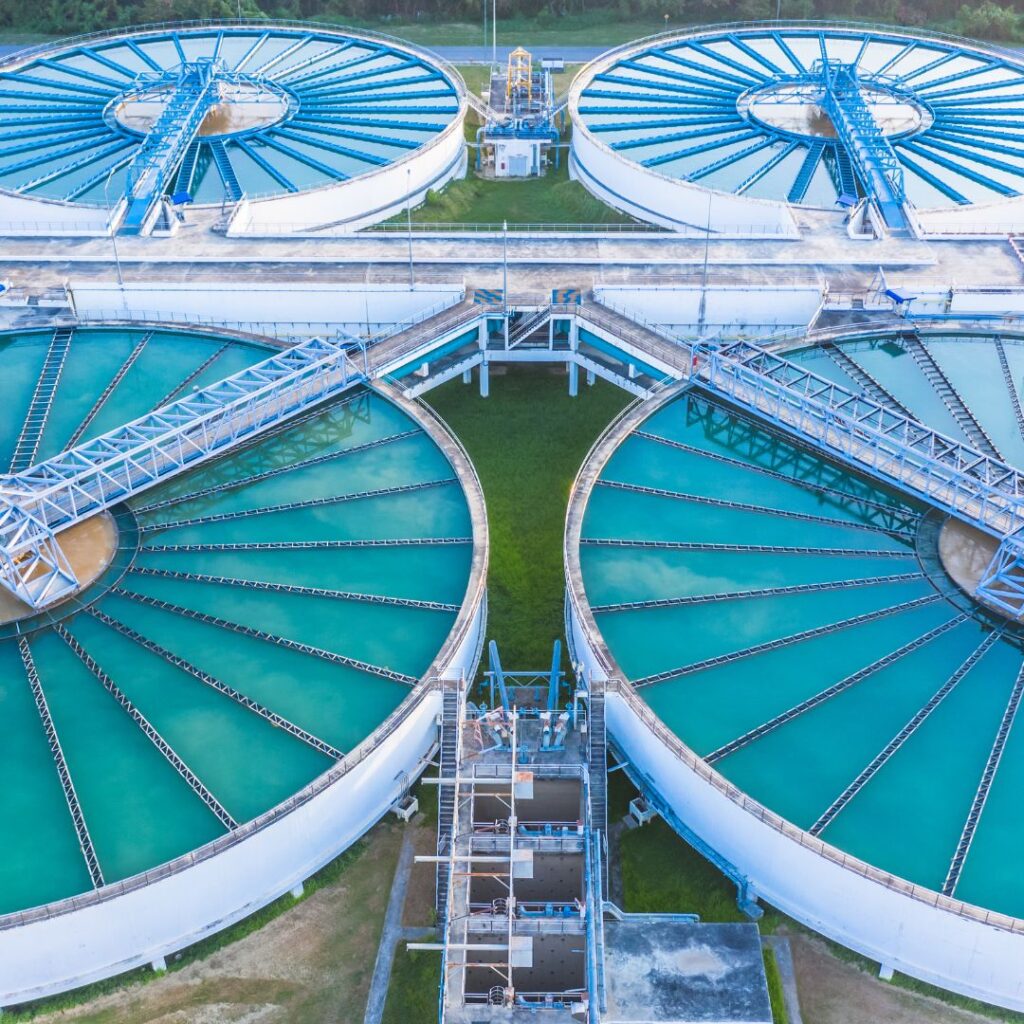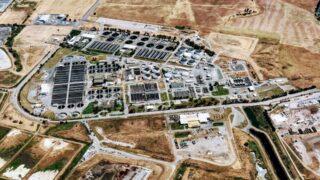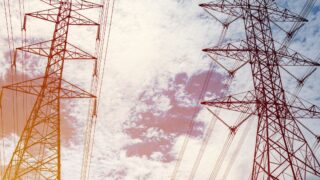Unraveling the Magic: How Does a Drinking Water Treatment Plant Work?
Clean drinking water is a fundamental necessity for all living beings. Every time we turn on our taps to fill a glass or take a refreshing shower, we rely on a complex and often underappreciated system that ensures the water we use is safe and pure.
In this blog post, we will unravel how a drinking water treatment plant works, shining a light on the processes that make this magic happen.
The Source of Water
Before diving into the challenges associated with different water sources, it’s essential to identify where the majority of US water sources originate.
Identifying the Water Sources
In the United States, the primary sources of drinking water are surface water bodies such as rivers, lakes, and reservoirs, accounting for approximately 61% of the total water supply. Groundwater from wells constitutes about 25%, while other sources like desalination and rainwater harvesting make up the remaining less than 1%. These figures highlight the significance of surface water and groundwater in meeting the nation’s water demand.
Challenges with Different Water Sources
Now, let’s delve into the challenges posed by various water sources:
Surface Water Challenges
Surface water sources are susceptible to pollution from agricultural runoff, industrial discharge, and urban contaminants such as PFAS. A study by the Environmental Protection Agency (EPA) revealed that around 46% of rivers and lakes in the US do not meet water quality standards due to pollution.
Furthermore, surface water availability can fluctuate seasonally, leading to challenges in maintaining a consistent water supply. According to the US Geological Survey (USGS), many regions experience increased water scarcity during dry seasons.
Groundwater Challenges
Groundwater is often over-extracted for agricultural, industrial, and municipal use. A report published in Earth’s Future Journal highlights that groundwater withdrawals have steadily increased, leading to concerns about aquifer depletion.
Also, groundwater sources are susceptible to contamination from leaking underground storage tanks, septic systems, and hazardous waste sites. A survey by the USGS found that nearly 23% of domestic wells had at least one contaminant at levels of potential health concern.
Desalination Challenges
Desalination of seawater requires substantial energy input, making it energy-intensive and potentially contributing to greenhouse gas emissions. In fact, desalination plants can be responsible for a significant carbon footprint. Plus, the discharge of concentrated brine back into the ocean can harm marine ecosystems.
First Stage of Treatment
The first stage of treatment is mostly for surface water treatment because surface water sources usually require more treatment than groundwater. Plus, it is the first line of defense in how a drinking water treatment plant works. They are responsible for preparing raw water for further, more complex treatment stages.
Screening: Removing Large Debris
Screening involves the removal of large debris, such as leaves, sticks, trash, and aquatic organisms, from the incoming raw water. This step ensures that the water entering the treatment plant is free from visible contaminants, preventing damage to equipment and improving the efficiency of subsequent treatment processes.
Coagulation: Clumping Contaminants Together
Coagulation is the second step in preliminary treatment, where chemicals, often coagulants like aluminum sulfate (alum) or ferric chloride, are added to the water. These chemicals create conditions that cause fine particles and contaminants to clump together into larger particles called flocs. These flocs are easier to remove during subsequent treatment processes.
Flocculation: Enhancing Particle Clumping
Flocculation is a critical primary treatment process where chemicals are added to water following coagulation during preliminary treatment. These chemicals, often referred to as flocculants, aid in the creation of larger and denser flocs by enhancing particle clumping. The goal is to facilitate the removal of suspended and colloidal particles that remain in the water after preliminary treatment.
Sedimentation: Settling Down Suspended Particles
According to the World Health Organization (WHO), sedimentation is a critical step in water treatment, particularly in developing countries, where it helps eliminate suspended solids, reducing the risk of waterborne diseases.
Sedimentation is the third step in preliminary treatment, where water is allowed to sit undisturbed in large tanks. During this process, gravity causes the heavier particles and flocs created during coagulation to settle to the bottom of the tank, forming a layer of sludge. The clarified water is then carefully collected from the top.
Second Stage of Treatment

The second stage of treatment is integral in the journey of transforming raw water into safe and potable drinking water. This stage focuses on the removal of impurities, sediments, and contaminants that could adversely affect water quality.
Filtration: Removing Fine Particles
Filtration is a pivotal process in primary treatment, where water is passed through layers of various filter media, including sand, gravel, and anthracite coal. This method is highly effective in removing remaining fine particles, microorganisms, and impurities, resulting in significantly improved water quality. Studies show that granular filtration processes consistently achieve removal rates of 99% or higher for particulate matter, ensuring water clarity and safety, while increasing disinfection efficiency.
Disinfection: Eliminating Harmful Pathogens
Disinfection is the final primary treatment process, and its primary objective is to eliminate harmful pathogens, including bacteria, viruses, and parasites, which may still be present in the water. Common disinfection methods include chlorination, UV irradiation, and ozonation, each with its unique advantages.
Drinking Water Treatment Technologies
These technologies represent the pinnacle of water treatment, focusing on the removal of specific contaminants and ensuring the highest quality of drinking water.
Activated Carbon Adsorption: Removing Chemicals and Odors
Activated carbon adsorption is an advanced treatment process that specializes in the removal of a wide range of chemicals and odors from water. A study highlighted that activated carbon can effectively remove chemicals such as PFAS, volatile organic compounds (VOCs), pesticides, and industrial contaminants. The porous nature of activated carbon provides a large surface area for adsorption, making it a powerful tool for improving the taste and odor of treated water.
Reverse Osmosis: Eliminating Dissolved Impurities
Reverse osmosis (RO) is a highly advanced process that relies on a semipermeable membrane to remove dissolved impurities, including salts, minerals, and even some organic compounds. According to research conducted by El-Salam, reverse osmosis can achieve removal rates exceeding 90% for dissolved solids. This process is invaluable for producing exceptionally pure water and is often employed in desalination plants to convert seawater into potable water.
UV Disinfection: Destroying Residual Microorganisms
UV disinfection stands as a formidable barrier against residual microorganisms that may persist in the treated water. Plus, it can achieve a high degree of inactivation for a wide spectrum of microorganisms, including bacteria, viruses, and protozoa. Its ability to destroy the DNA of these pathogens ensures the delivery of safe and microbiologically clean drinking water.
Removing Specific Contaminants
In the quest for pristine drinking water, it is essential to address specific contaminants that may pose health risks.
Nitrate and Nitrite Removal
Nitrate and nitrite removal processes are critical for safeguarding water quality, particularly in agricultural regions where nitrate contamination is prevalent. Advanced treatment techniques, such as ion exchange and biological denitrification, can effectively reduce nitrate concentrations to safe levels.
Arsenic Removal
Arsenic removal is a crucial consideration in areas where natural arsenic contamination exists. Research highlights the significance of technologies like adsorption, coagulation-filtration, and flocculation in reducing arsenic levels to meet regulatory standards. However, they have a few limitations such as high energy demand, reduced efficiency and andic compounds. Effective treatment processes are essential for mitigating the health risks associated with arsenic exposure.
Fluoride Removal
Fluoride removal is essential to ensure that drinking water contains safe levels of this mineral. The World Health Organization (WHO) reports that excessive fluoride levels can lead to dental and skeletal health issues, called skeletal fluorosis. Adsorption on activated alumina and ion exchange are common methods employed to remove excess fluoride and provide water that is both safe and healthy for consumption.
Handling Disinfection Byproducts
While disinfection is critical for pathogen removal, it can lead to the formation of disinfection byproducts (DBPs), which require mitigation to maintain water quality. Research reveals that over 50% of the total organic halides (TOX) found in treated water are attributed to DBPs.
Advanced treatment techniques, such as enhanced coagulation, can help mitigate DBP formation by reducing the precursor organic materials in water. These processes play a crucial role in ensuring that the water delivered to consumers not only meets stringent standards but also exceeds expectations for purity and safety.
Energy Efficiency and Sustainability
As environmental concerns and sustainability become increasingly important, water treatment facilities are exploring ways to operate more efficiently and reduce their environmental impact.
Implementing Green Practices
Implementing green practices within water treatment facilities involves adopting energy-efficient technologies and sustainable practices. There is a potential for water treatment plants to reduce energy consumption through measures like improved process control, energy-efficient pumps, and renewable energy integration. These practices not only reduce operational costs but also contribute to a lower carbon footprint.
Reducing Environmental Impact
Reducing the environmental impact of water treatment is a multifaceted challenge. According to the World Health Organization (WHO), water treatment processes can be energy-intensive and contribute to greenhouse gas emissions. However, the use of sustainable materials in infrastructure construction can significantly reduce the environmental footprint of water treatment plants.
Transcend Design Generator helps water treatment plant utilities evaluate a myriad of options in their capital planning and conceptual design processes. By harnessing its capabilities in generative design, you can seamlessly identify and implement sustainable practices, optimizing their systems for reduced energy consumption and minimized environmental impact.
Upgrading Aging Infrastructure

Similar to wastewater treatment plants, aging water treatment plants confront numerous challenges, including deteriorating pipelines, outdated equipment, and increased maintenance costs. Aging infrastructure can result in water quality issues, service disruptions, and inefficiencies.
Modernization Strategies
To address the challenges of aging infrastructure, modernization strategies are being implemented. These strategies ensure the continued reliability and performance of water treatment facilities while extending their service life and minimizing disruptions to the public.
Transcend Design Generator serves as a valuable ally in this endeavor, empowering utilities to make data-driven decisions that enhance the effectiveness of modernization initiatives. By leveraging its capabilities, you can optimize resource allocation, prioritize critical upgrades, and integrate sustainable practices into the modernization process. This not only ensures the longevity and resilience of water treatment facilities but also aligns with broader goals of energy efficiency and environmental responsibility.
Dealing with Emergencies
Contingency plans for natural disasters are essential to ensure the resilience of water treatment facilities. Natural disasters, including hurricanes, floods, and earthquakes, can disrupt water treatment operations and jeopardize water quality. Robust contingency plans encompass emergency power supply, backup water sources, and rapid response protocols to mitigate the impact of disasters.
Early detection systems and swift response measures are important in preventing waterborne disease outbreaks. Rapid response and communication with the public are vital aspects of managing contamination incidents effectively.
Public Outreach and Education
Public outreach and education not only inform the community but also empower individuals to make informed choices about water consumption and conservation.
Raising Awareness about Drinking Water Quality
Raising awareness about drinking water quality is essential to ensure that the public understands the importance of safe and clean water. Communities that actively engage in water quality awareness programs tend to have a stronger sense of ownership and responsibility for their water sources. These programs emphasize the role that each individual plays in maintaining water quality, from avoiding contaminant runoff to reporting unusual water odors or colors.
Encouraging Water Conservation
Encouraging water conservation is vital, particularly in regions facing water scarcity or drought. Data from the U.S. Geological Survey (USGS) indicates that the average American uses about 80-100 gallons of water per day. Educational campaigns and community initiatives can significantly reduce water consumption. By promoting practices such as fixing leaks, using water-efficient appliances, and reducing outdoor water use, communities can contribute to the sustainable management of water resources.
Addressing Water Scarcity
Addressing water scarcity is becoming increasingly critical in regions facing water stress due to population growth and changing climate patterns. This challenge demands innovative approaches to water management.
Implementing Water Reuse Programs
Implementing water reuse programs is a proactive strategy that conserves water resources. Recycling treated wastewater for non-potable uses, such as irrigation, industrial processes, and even indirect potable reuse, can alleviate the pressure on traditional water sources and contribute to sustainability.
Exploring Alternative Water Sources
Exploring alternative water sources is essential in regions with limited freshwater availability. For example, desalination plants can convert seawater into freshwater, effectively increasing the available water resources. However, such approaches require careful planning and consideration of environmental impacts.
Summary
The journey of turning raw water into safe, potable drinking water is a marvel of engineering, science, and dedication. Every time we turn on our taps, we benefit from a complex system designed to ensure the water we use is pure and safe for consumption.
From identifying the diverse sources of water, including surface water, groundwater, and alternative sources, to addressing the unique challenges each source presents, such as pollution, scarcity, and energy-intensive desalination, every step of the water treatment process is carefully considered and executed.
Explore how Transcend Design Generator can empower your water treatment endeavors with innovative solutions and sustainable practices.







